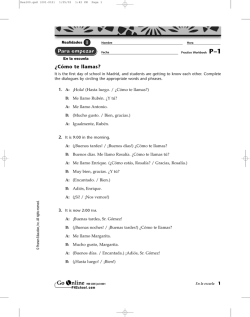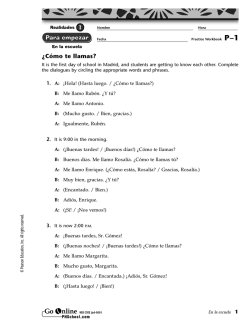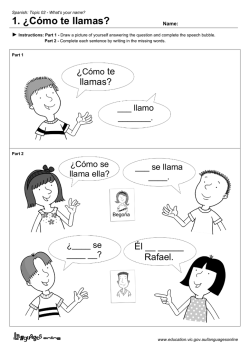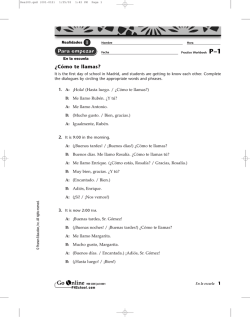
¿Cómo te llamas tú?
1 Students tell what their names are. Students comprehend the question, “¿Cómo te llamas tú?” Students answer the question using the phrase, “Me llamo ____.” (Track #) ¿Cómo te llamas tú? Me llamo ____. What is your name? My name is ____. Cada vez que nos juntamos (1) Buenos días (2) Me llamo, me llamo (3) Cabeza, hombros, piernas, pies (4) Mi cuerpo (5) Margarita y Margaret, by Lynne Reiser This book celebrates the power of knowing two languages. Talking about that power provides an excellent opportunity to get a new class excited about Spanish. Me llamo autoretrato 1 Summary: Through songs, the role-play, and the art project, students learn to tell what their names are by answering the question, “¿Cómo te llamas tú?” Supplies: A small ball or hacky sack First Day 1. Greeting and Roll Call (1.1, 1.2, 4.1) 2. Circle Time Warm up with songs, chants, and poems. (1.1, 1.2, 1.3, 2.1, 3.1, 3.2, 5.2) Play the Me llamo game: 1. Show students your ball or hacky sack. Say, “Esta es la pelota mágica.” Have students repeat “la pelota mágica.” 2. Hold la pelota mágica up, drop it in your lap, and say, “Me llamo Señor/Señora ____.” 3. Pass la pelota mágica to a student and ask, “¿Cómo te llamas tú?” 4. You can help the student respond by saying, “Me llamo (student’s name).” Have the student repeat. 5. After the student responds, sing “Me llamo, me llamo” (Sonrisas CD, track #3) and insert the student’s name in the appropriate spot in the song. 6. Have the student pass the ball back to you and repeat the process with each student. 3. Story Time (1.2, 2.1, 3.2, 4.1, 4.2) 4. Art Time (1.1, 1.2, 1.3, 3.1) 5. Good-bye (1.1) Second Day 1. Greeting and Roll Call (1.1, 1.2, 4.1) 2. Circle Time (1.1, 1.2, 1.3, 2.1, 3.1, 3.2, 5.2) Warm up with songs, chants, and poems. Play the Me llamo game from the first day. If you want your students to use Spanish names in the classroom, this is a good time to choose them and then use them in the Me llamo game. 3. Story Time (1.2, 2.1, 3.2, 4.1, 4.2) 4. Art Time (1.1, 1.2, 1.3, 3.1) 5. Good-bye (1.1) Because this is the first lesson and the first game, you will probably have to do a lot of the answering for your students in the game. This is okay; your students will catch on quickly and will easily be able to do the game in Spanish after only a few classes. Students draw a self-portrait and label it with the answer to “¿Cómo te llamas tú?” Construction paper Crayons First Day 1. Show students a model of your self-portrait. Point out the different facial features you drew and have the students repeat the words in Spanish. Tell students they are going to draw their own self-portraits and include all of the same facial features. 2. Pass out construction paper and crayons. 3. Have students draw their self-portraits. As they are drawing, go around and point to the different facial features and have them repeat the words in Spanish. Second Day 1. Show students your self-portrait. Model for them how to label it with “Me llamo ____.” 2. Pass out their self-portraits and crayons. 3. Have students write “Me llamo ____” on their portraits. 4. When students are finished, have them present their self-portraits to their classmates. Ask them, “¿Cómo te llamas tú?,” and have them answer with the correct phrase. Some young children will draw very simple pictures of themselves. Encourage them to include all the facial features by asking them questions such as “¿Y una nariz? ¿Tienes una nariz?” You may have to help younger students label their self portraits. Date _________________________ 1 Student _________________________ Students tell what their names are. Students comprehend the question, “¿Cómo te llamas tú?” Students answer the question using the phrase, “Me llamo ____.” (Track #) ¿Cómo te llamas tú? Me llamo ____. What is your name? My name is ____. Cada vez que nos juntamos (1) Buenos días (2) Me llamo, me llamo (3) Cabeza, hombros, piernas, pies (4) Mi cuerpo (5) Margarita y Margaret, by Lynne Reiser This book celebrates the power of knowing two languages. Have your child show you their self-portrait from Spanish class and ask them to read what it says. 13 Students engage in conversation by using phrases and commands associated with bedtime and waking up. Students comprehend and use the phrases, “Acuéstate,” “Cierra los ojos,” “Buenas noches,” “Despiértate,” and “Buenos días.” (Track #) Acuéstate. Cierra los ojos. Buenas noches. Despiértate. Buenos días. Lie down; go to bed. Close your eyes. Good night. Wake up. Good morning / good day. Cada vez que nos juntamos (1) Cabeza, hombros, piernas, pies (4) Mi cuerpo (5) Había un chorrito (11) Te quiero (12) Mamá y papá (13) Buenas noches (14) El sol se llama Lorenzo (15) Gorra, camisa, pantalones, zapatos (18) Aquel caracol (22) Tortillitas (4) Los deditos (5) Estos piecitos (7) Sana, sana (16) Buenas noches, luna, by Margaret Wise Brown Buenas noches a todos, by Lone Morton and Rosa Martin ¿Es hora?, by Marilyn Janovitz Gatitos dormidos Pinta la noche con esponjas 13 Summary: Through songs, the activity, stories, and the art project, students learn phrases associated with going to bed and waking up. Supplies: A premade gatito puppet from art project (see page 123) First Day 1. Greeting and Roll Call (1.1, 1.2, 4.1) 2. Circle Time (1.1, 1.2, 1.3, 2.1, 3.1, 3.2, 4.1, 5.2) Start with calendar activities. Warm up with songs, chants, and poems. Review with games and activities from previous lessons. Do the Buenas noches, buenos días role-play: 1. Tell students that your friend gatito is tired and that he needs to lie down. 2. Say, “Acuéstate, gatito,” and gently place the puppet on the floor. Have students repeat, “Acuéstate, gatito.” 3. Then tell the students that gatito needs to go to sleep, and we need to tell him goodnight. 4. Close the puppet’s eyes and say, “Buenas noches, gatito.” Have students repeat, “Buenas noches, gatito.” 5. After a few seconds, tell students that it is time for gatito to wake up. Say, “Despiértate, gatito.” Have students repeat, “Despiértate, gatito.” 6. Open the puppet’s eyes and exclaim, “¡Buenos días, gatito!” Have students repeat, “¡Buenos días, gatito!” 7. You can repeat this role-play as many times as your students want to. 8. Tell students they are going to make their own gatito puppet in the art project. 3. Story Time (1.2) 4. Art Time (1.1, 1.2, 1.3, 3.1) 5. Good-bye (1.1) Second Day 1. Greeting and Roll Call (1.1, 1.2, 4.1) 2. Circle Time (1.1, 1.2, 1.3, 2.1, 3.1, 3.2, 4.1, 5.2) Start with calendar activities. Warm up with songs, chants, and poems. Review with games and activities from previous lessons. Do the Buenas noches, buenos días role-play. 3. Story Time (1.2) 4. Art Time (1.1, 1.2, 1.3, 3.1) 5. Good-bye (1.1) You can extend the role-play by asking the students if they are tired and want to go lie down. Go through the same steps with them as you did with the puppet. Students construct their own gatito puppet and use it to do the Buenas noches, buenos días role-play. Gatitos dormidos photocopy, one for each student (see Reproducibles, page 279) Crayons Glue Scissors First Day 1. Have students cut out the gatito head from the photocopy. Then follow the folding and cutting instructions in order to make the eyes. 2. Have students cut out the flap from the photocopy. 3. Have students glue the flap on the back of the gatito. (The back is the side with the folding instructions.) 4. Make sure that they do not glue the eyes shut on the gatito. 5. Let glue dry until next lesson. Second Day 1. Model for students the different facial features they can color on the gatito head. 2. Have students color their gatitos. 3. When they have finished, have students go through the Buenas noches, buenos días role-play with their own gatitos. You can make a more sturdy gatito puppet if you use construction paper, but this does make the folding and cutting for the eyes more difficult. With young students, you may wish to prepare the heads ahead of time and simply have them do the coloring. Students create sponge paintings of the night sky. Black or dark blue construction paper Yellow or white tempera paint Paint trays Sponges cut in the shape of moons and stars (stars can be little dots) 1. 2. 3. 4. Model for students how to create a sponge painting of the night sky using sponges dipped in tempera paint. Pass out materials to students and allow them to create their own paintings. As students are working go around and point to the stars and the moon and say, “Buenas noches, estrellas; buenas noches, luna.” Have students repeat. As students finish, have them write “Buenas noches” at the bottom of their paintings. This project can be done in one day. It complements the reading of one of the recommended book for this lesson, Buenas noches, luna. Date _________________________ 13 Student _________________________ Students engage in conversation by using phrases and commands associated with bedtime and waking up. Students comprehend and use the phrases, “Acuéstate,” “Cierra los ojos,” “Buenas noches,” “Despiértate,” and “Buenos días.” (Track #) Acuéstate. Cierra los ojos. Buenas noches. Despiértate. Buenos días. Lie down; go to bed. Close your eyes. Good night. Wake up. Good morning / good day. Cada vez que nos juntamos (1) Cabeza, hombros, piernas, pies (4) Mi cuerpo (5) Había un chorrito (11) Te quiero (12) Mamá y papá (13) Buenas noches (14) El sol se llama Lorenzo (15) Gorra, camisa, pantalones, zapatos (18) Aquel caracol (22) Tortillitas (4) Los deditos (5) Estos piecitos (7) Sana, sana (16) Buenas noches, luna, by Margaret Wise Brown Buenas noches a todos, by Lone Morton and Rosa Martin ¿Es hora?, by Marilyn Janovitz Have your child use his or her gatito from the art project to show you how to put it to bed using the vocabulary from the lesson.
© Copyright 2024




